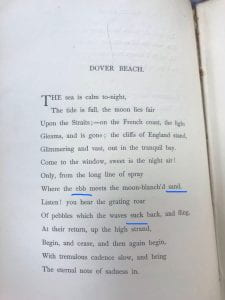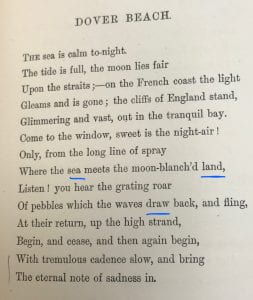Arnold, Matthew. New Poems. vol. 2, London, Macmillan and Co, 1867. ABLibrary Non Rare 821.8 A757n
Arnold, Matthew. Lyric and Elegiac Poems. vol. 2, London, Macmillan and Co, 1888. ABLibrary Rare X 821.8 A757po
Rare Item Analysis: Tracing the Evolution of Matthew Arnold’s Religious Thought: An Analysis of Stylistic Changes to “Dover Beach”
By Laura G. Southern
COVE timeline | COVE timeline entry | COVE map
For the purpose of this blog post, two versions of Matthew Arnold’s “Dover Beach” will be compared: the first edition published by Macmillan in an 1867 collection of Arnold’s poems titled New Poems, and an 1888 edition published within another collection titled Lyric and Elegiac Poems. The 1867 edition will be used as the “original” text to show not only how the evolution of stylistic changes such as diction choice and capitalization influence the poem’s overall meaning, but also to reflect on how we might trace the evolution of Arnold’s religious thought. What do Arnold’s stylistic changes between 1867 and 1888 reveal about his developing perception of religion and science? To even begin pondering this question, the context of Arnold’s personal beliefs on religion and science must first be understood. It must also be noted that 1888 was the last year of Arnold’s life. According to the Oxford Dictionary of National Biography, Arnold most likely wrote “Dover Beach” in the early 1850s, which was a time when religion and science were commonly viewed as antithetical. This bleak, opposing viewpoint is seen in the first edition. Then, near the end of his life in the 1870s and 80s, Arnold began to more widely promote the Church of England. At this point, he personally reconciles science and religion by rejecting “the literalist interpretation of the Bible,” instead viewing the Bible and the Church as more of a historical text and lens by which good morals can be learned (Collini). Later in his life, Arnold places more importance on this revised version of Christianity. With this context in mind, Arnold’s religious shift can now be seen through an exploration of the 1867 and 1888 editions of “Dover Beach.” By analyzing the stylistic changes Arnold makes to the poem, it becomes clear that Arnold’s edits to word choice and capitalization work to provide insight into how his views of religion and science change: uncertain to hopeful for a return of faith as a moral guide for the nation.

Fig. 1. Photo taken by Laura Southern
The greatest change from the 1867 to 1888 versions of “Dover Beach” is Arnold’s choice of diction. As shown in the 1867 version image above (Fig. 1), small words such as “ebb,” “sand,” and “suck” are underlined in blue (8-10). These three terms are different by the 1888 version, and the newly chosen words are underlined in blue in the picture below (Fig. 2):

Fig. 2. Photo taken by Laura Southern
While the alteration of three one-syllable words might seem trivial, in reality each change is quite relevant. In line 8, the word “ebb” becomes “sea” and “sand” becomes “land.” With the overarching metaphor of the poem being the Sea of Faith, which I will go into more detail about later, the choice of adding an extra “sea” seems to fit thematically with the poem’s questions about religious faith. In fact, it could be seen to reinforce religious undertones by establishing a more direct allusion to the Sea of Faith earlier in the poem. Arnold’s choice to replace “sand” with “land” is also intriguing, as the sand/land imagery carries with it a Biblical allusion to Matthew 7: 24-27:
Therefore everyone who hears these words of mine and puts them into practice is like a wise man who built his house on the rock. The rain came down, the streams rose, and the winds blew and beat against that house; yet it did not fall, because it had its foundation on the rock. But everyone who hears these words of mine and does not put them into practice is like a foolish man who built his house on sand. The rain came down, the streams rose, and the winds blew and beat against that house, and it fell with a great crash. (New International Version)
The idea of “land” is much more concrete than sand, which slips away every time a wave pulls against it on its way back out to sea. This idea of eroding, which can also be applied in terms of how faith is impacted or eroded by scientific claims, is consequently replaced with an image of solidity. It also fits in with the way Arnold comes to defend the Bible—as a text to offer a roadmap of sorts for people, a set of rules that include practical tips such as building on strong foundations (metaphorically and physically). Additionally, Arnold changes “suck” to “draw” in line 10. The word “draw” has the implied meaning of pulling forward and away, and can also mean to attract something. By describing the water, which thematically represents the Sea of Faith that Arnold mentions later in the poem, as a force that draws, Arnold might be alluding to how religion will one day be drawn back in by people’s faith. It “ebb[s],” as he says in line 17, and this diction choice of “draw” implies that what goes out will eventually be attracted back in. Overall, each time Arnold makes a stylistic choice in regards to diction, he is intentional. The image of the sea is brought up earlier, planting religious undertones sooner; “land” alters the significance of the biblical allusion; and “draw” lends more toward the idea of the return of faith than “suck” does.

Fig. 3. Photo taken by Laura Southern; Left 1867; Right 1888
Arnold’s choice of capitalization also plays an integral role in understanding how his viewpoint of religion grows from rather bleak to more reliant on the idea that a new form of religion will indeed return. The only stylistic change in regards to capitalization occurs in line 21: “The sea of faith” becomes “The Sea of Faith” (Fig. 3). Capitalizing the word “sea” immediately calls forth the first time Arnold uses the word in line 8, as discussed in the paragraph above. This solidifies the idea of the sea representing religion/faith and threads it more absolutely throughout the poem. The capitalization of “faith” works in the same way, but also goes a level deeper by directly stating that Arnold is viewing the sway of the sea in stanza one as a metaphor for how faith comes and goes. Without the capitalization of “sea of faith,” the theme of faith is not given as much importance. If Arnold left the line lowercased, it would not demand the reader’s attention and Arnold’s ideas for a new religious revival would not be as easily seen. His choice to capitalize “Sea of Faith” is important because it shows that he now has more reverence for the religious allusions in his poem. It also supports the idea that in the 1870s and 80s, his idea of religion evolves into an understanding that a revised form of faith is needed because it provides a moral framework for humanity.
It is interesting how stylistic changes can reveal a poet’s inner conflicts and the evolution of his or her thought. Since no letters or other forms of writing such as journal entries have been found to explain why Matthew Arnold decided to make revisions to “Dover Beach,” comparing the changes he did make with the historical information we do have about his religious views works to give scholars an inkling of an answer. And if not a solid answer, at least an insight into how his ideas for using a new form of religion without miracles, etc. could cause a positive resurgence of the nation’s adherence to good morals. These insights are what make analyzing a poem’s stylistic changes valuable. We get a glimpse into the political climate at the time of the poem’s publication, and in this case, we are able to see how people like Arnold internalized and dealt with conflicts such as faith and scientific discoveries. Scholars can use such analysis to answer questions still surrounding the poem, such as: How do we deal with the foreboding imagery of the darkling plain in light of the Sea of Faith? And most importantly, how can we shift this line-by-line level of analysis to other poems in the classroom? Analyzing a poem in this way helps make broad concepts that might be hard to understand accessible, and it allows the students to make the discovery themselves. For example, I read quite a bit about Arnold’s ideas for religion, but it was not until I considered whyhe revised certain words and capitalizations that I understood how his beliefs were put into action. I realized why the larger concepts were vital to understanding the poem’s complex meaning. Therefore, I believe classrooms can utilize my comparison of the 1867 and 1888 editions of “Dover Beach” as an example for a classroom exercise. Assign students short readings about the greater context surrounding a poem, and then, in class, foster a discussion forhow they see these contexts influencing a poet’s stylistic changes, no matter how small. Then comes the fun part, which is asking students what their discoveries mean for the poem’s meaning and the poet’s life.
Works Cited
Collini, Stefan. “Arnold, Matthew.”Oxford Dictionary of National Biography, 2004, https://doi.org/10.1093/ref:odnb/679.
The Bible. New International Version, Biblica Inc., 2011.
